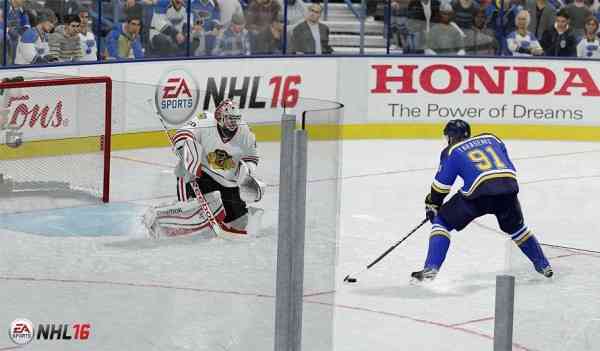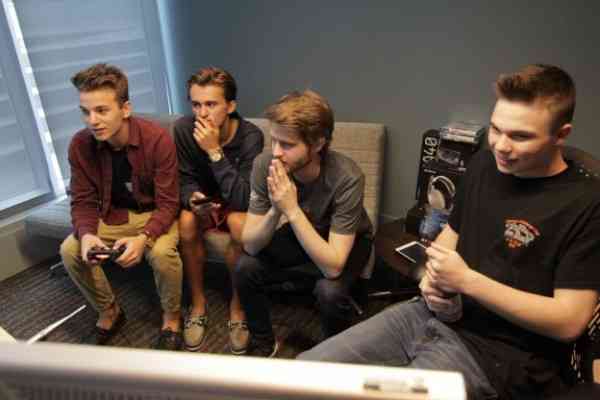There is a well-known old saying that the Chinese have one word for the two ideas of “crisis” and “opportunity.” Of course, the saying is wrong – the Chinese have no such word. But it is a nice thought; out of every crisis, there can emerge an opportunity, if one is willing to see it. And it sums up perfectly the position that Sean “Rammer” Ramjagsingh and the folks at EA developing NHL 16 have been in for the past year. Facing what can fairly be called a crisis after the poorly-received launch of NHL 15, Rammer and his team found themselves on the hot-seat to make a comeback this year. The stakes couldn’t have been bigger; here is a gaming series, NHL, that is among the oldest and biggest-selling ever. It is woven into the memories and childhoods of a generation in a way that is rare for video games. Another disappointment was not an option – the franchise had to be saved, and the NHL 16 team had to deliver.
When you’ve got a huge project to deliver – like a flagship gaming title for a global studio – you need the right people at the helm, people who can come up with a plan under pressure without panicking. Meeting Rammer at the EA Vancouver studios in early September, I got the feeling immediately that he is the kind of guy you want – and not because he happens to be almost 7 feet tall. It’s because he exudes a calm, but clear passion for his work, while at the same time having a hell of a lot of fun doing it. He understands what the fans want, while being able to make the tough decisions on the business-side. The same is true of his Associate Producers, Cement Kwong, Ben Ross, and Andy Agostini. Walking me through their development process, they made it clear that while they may have been living and breathing NHL 16 for the past year, their enthusiasm for what they do has not wavered one bit.
The team’s experience and knowledge could have been a liability in their current situation, causing them to dismiss the criticism of NHL 15, retreat behind EA Vancouver’s walls, and put out the game they wanted, regardless of what anyone else said. But they knew that that would be a mistake. Instead, they did the opposite – they decided to turn this crisis into an opportunity – to step back, and listen to what the fans were telling them. They decided to use this moment to make the next NHL – NHL 16 – not only better than 15, but one of the best ever.
“After the NHL 15 launch, we really made a concerted effort to work as close with the fans as possible, getting research done, to understand what they wanted from our game,” recalls Rammer. “For EA Sports Hockey League specifically, after NHL 15, we understood that it was an opportunity for us, to rework, reinvent, and reimagine the mode, and make sure that we worked with the fans to dial that in, and deliver what they wanted.”
________________________________________
“And make no mistake – the Game Changers are not just a group of guys playing the game in EA’s studios and giving tips and pointers.”
The problem was, what fan feedback should they listen to? Wading through the labyrinthine network of forums and comment-boards on the Internet, with its myriad of opinions – some coherent, many incoherent or even contradictory – would leave a person no closer to knowing what the fans really wanted. That’s when the Game Changers – a small group of experienced NHL gamers, chosen by the fans to represent them – were brought in. In the Game Changers, Rammer and the team created the perfect conduit for channeling the opinions of the masses into focused, useful feedback that could be regularly consulted, and incorporated into the game at every step of the build process.
“[The Game Changers] really allowed us to get to the heart of what the community wanted,” says Rammer. “These are 12 guys, most of them nominated by the community themselves to represent the community. Because there’s so many different ways to get feedback, there’s so much feedback out there, and these guys have been able to help us decipher what the feedback really means, and what the people actually wanted.”
And make no mistake – the Game Changers are not just a group of guys playing the game in EA’s studios and giving tips and pointers. Their involvement was almost 24 hours a day, 7 days a week, with access to the dev team and the game-builds that was so complete, it almost made Rammer nervous.
“When we started the Game Changers program, we didn’t know what we were going to get, because we were exposing our Feature set earlier than we ever had before, and it’s been unbelievable – helping us develop our Feature set, giving us feedback during the development process as the Features started coming together, and support. Plus, we’ve had a 24/7 Skype Live Chat going with them, where we could ask high level, or really, really low-level questions – like about what movement should go on a specific button – and we would get real-time feedback, real-time discussion, at all hours of the night.”
In other words, this wasn’t just your typical fan-feedback “focus group”; this was a whole new level of involvement, to the point that one can fairly say that the fans themselves had a huge role in developing NHL 16 on every level – from the menus, to the modes, to the visuals. I witnessed the process first-hand during a visit to the Vancouver studios in early September. At that late stage – the game was set to release just a couple of weeks later – I didn’t expect to hear the Game Changers give the dev team much serious feedback. Surely, judging by the game’s complete state, there couldn’t be much more to fix. But, to my surprise, I still saw lots of discussion taking place. As Associate Producer Ben Ross called for suggestions, the Game Changers had lots to say about the game even at that late stage, about visuals, animations, and controls. I got the sense that this was a process that would continue well after NHL 16 was even released – clearly, EA has embraced the Game Changers model for the long-haul, which bodes well for the franchise’s future iterations.
Now, the cynic might point out that you don’t need Game Changers to tell you what was wrong with NHL 15. Any 12 year old kid playing the game could tell you that the missing modes were the big issue – bring back the modes this year, and you’ve already made a huge improvement. But this is where Rammer and the crew pulled some opportunity out of the crisis once again – because besides the particular problems with last year’s game, their fan research helped them highlight another, longer-term issue that was perhaps just as important: they needed to do a better job of helping players, especially the more novice players, get better.
As Rammer explains, “there are lot of more casual fans whose memories of playing NHL games are NHL 94, or NHL 95, or NBA Live 95, where it was 2 or 3 buttons, and to look at a controller right now, they’re like, ‘yeah, I haven’t played since 94 or 95, and now there’s just too many buttons.’” And it wasn’t just the “casual fans” saying this either. Even when the EA NHL team watched the Game Changers play, they were seeing that the best players of NHL were not totally comfortable with all the game’s features.
“Our game is so deep now, that we want our experienced fans to be able to experience as much of that game as possible,” says Rammer. “Here [at EA Studios] we watch some of the most experienced players of NHL play, and they don’t maximize all of the controls that we have in the game, so why is that? So we’ve been doing a better job of exposing that. And for the newbies, we want to let them into the experience, and into the fun. The Visual On-Ice Trainer is something we talked about early on, and it was a focus for us.”
And I can say, from personal experience, that the new Visual On-Ice Trainer features, which came out of the Game Changers program, are indeed revolutionary. The new suggestion boxes above your player telling you how to make various moves and shots, the colored targets in the net when you shoot, the suggested passing lanes – it all really helped train me to be a better player in an amazingly-short time. It’s perhaps not a feature for everyone, and I am sure lots of hard-core players will turn it off. But, as a member of that demographic that Rammer and the team identified as needing a more accessible experience from NHL 16, I know this will bring me back with much more enthusiasm this year.
______________________________
“They completely changed the way they develop future NHL games, with a level of fan participation in the process that has been unprecedented.”
NHL 16 released on September 15th and it has been well-received, including here at COGconnected. But my visit and talk with the team at EA Sports in Vancouver showed me that the long process of bringing this revered video game series back to glory began immediately after NHL 15’s release. Rammer and the team didn’t just scramble to “put back” all the stuff that people missed. They completely changed the way they develop future NHL games, with a level of fan participation in the process that has been unprecedented. And it doesn’t take a genius to see that it has paid real dividends for EA and for players of NHL 16. It is one of the great recent comeback stories in gaming, and a good lesson to all game developers: listen to your fans, respect your fans, and you’ll make your fans happy.
NHL 16 is out now on PS4 and Xbox One.


